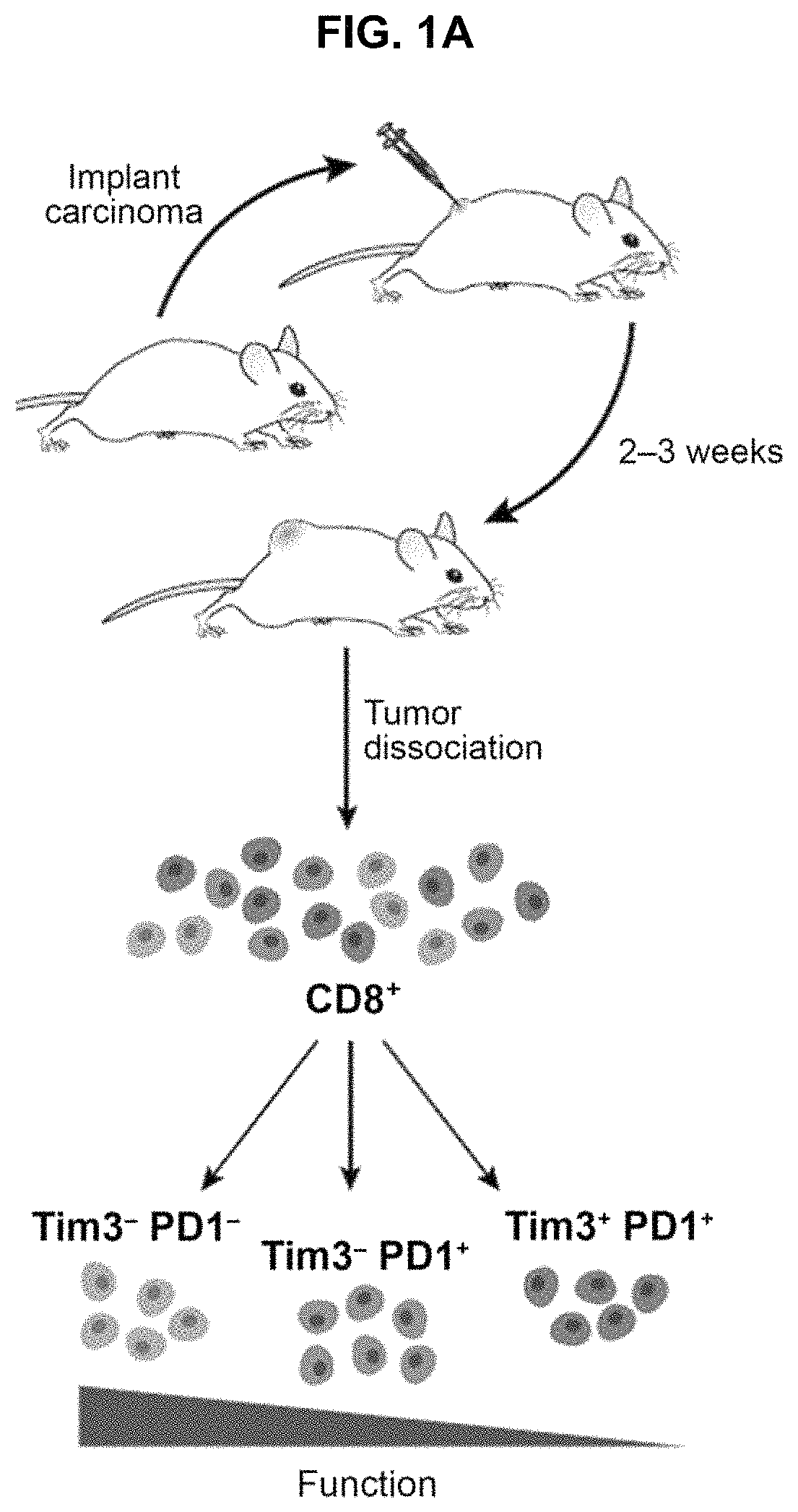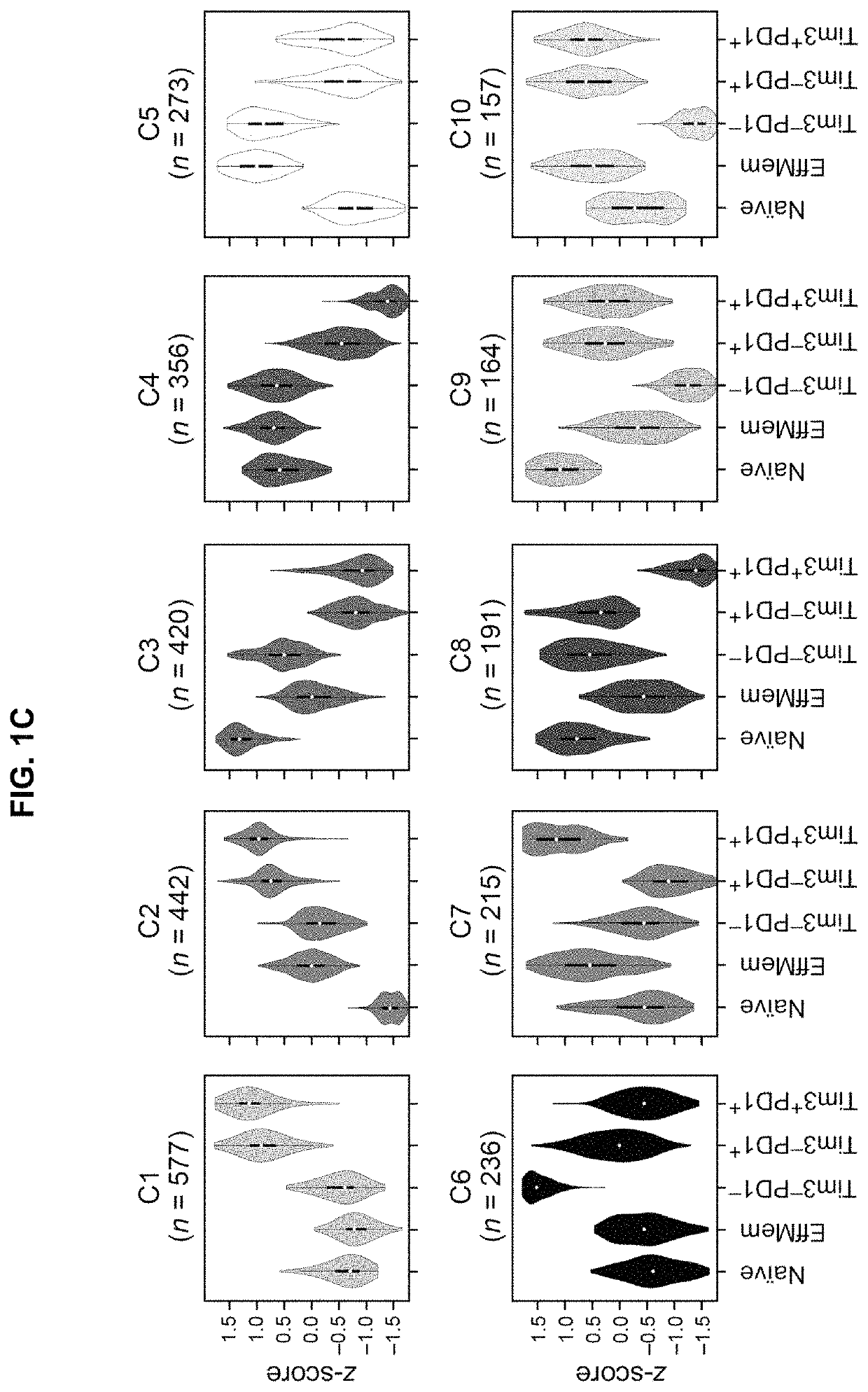Compositions and methods for evaluating and modulating immune responses by detecting and targeting POU2AF1
a technology of immune response and composition, applied in the field of compositions and methods for evaluating and modulating immune responses by detecting and targeting pou2af1, can solve problems such as complicated t cell molecular signatures, and achieve the effects of reducing immune response, reducing dysfunctional immune cells, and reducing expression of gene signatures
- Summary
- Abstract
- Description
- Claims
- Application Information
AI Technical Summary
Benefits of technology
Problems solved by technology
Method used
Image
Examples
example 2
ioneins (MT) are Differentially Expressed in CD8 Exhaustion in Cancer
[0893]The coupling of T cell activation and dysfunction at the transcription level has been observed previously (Doering et al., 2012, supra; Tirosh et al., 2016) and is expected given that T cell dysfunction / exhaustion arises from chronic T cell activation due to antigen persistence. However, the underlying molecular mechanisms that drive this association have not been identified. This raises the fundamental question of whether a distinct gene module for T cell dysfunction exists and if so is it exclusively expressed by a subset of CD8+ TILs.
[0894]To identify putative molecular regulators of the CD8+ T cell state might enable refinement of the dysfunction program signature. Applicants therefore focused on the genes of cluster 2. To identify putative molecular regulators of the CD8+ T cell dysfunction program Applicants ranked the Cluster 2 genes by their differential expression across the three TIL subpopulations,...
example 4
n Profiling of MT− / − TILs Identifies Distinct Programs for T Cell Activation and T Cell Dysfunction and T Cell Dysfunction
[0904]The Applicants further realized that the unexpected observation that the dysfunctional phenotype of DP CD8+ TILs was lost in the absence of MT1 and MT2 (FIGS. 3F,G, I), even though co-inhibitory receptors were expressed, provided a system allowing to gain an insight into the specific characteristics of T cell dysfunction in cancer by comparing the transcriptome of dysfunctional and non-dysfunctional CD8+ Tim3+PD1′ subpopulations. More particularly, transcriptional profiling of MT− / − TILs can decouple signatures of T cell activation and T cell dysfunction, allowing to distinguish within the dysfunction signature of Tim3+PD1+ TILs the gene module associated with T cell activation from the gene module that is only related to T cell dysfunction, leading to identification of the respective components of the activation and dysfunction programs. The Applicants hyp...
example 10
the Dysfunction and Activation Transcriptional Programs Gene Modules are Anti-Correlated and Uncoupled at the Single-Cell Level
[0969]The difference in transcriptional states of the bulk DN, SP, and DP populations between WT and MT− / − could stem from either changes in cell intrinsic states or from changes in the proportion of cells exhibiting different transcriptional states. To test whether the CD8+ TILs in vivo include cells that express only the dysfunction module but not the activation module, Applicants analyzed 1,061 CD8+ TILs with single-cell RNA-seq (516 WT and 545 MT− / − cells that passed QC thresholds from 1,504 processed cells. Applicants then assigned each cell with “signature scores” based on the relative extent to which it expressed the different module signatures (while controlling for the cell's profile complexity, a measure of quality, Experimental Procedures). The activation and dysfunction module scores were negatively correlated across cells (FIG. 11A), such that a...
PUM
 Login to View More
Login to View More Abstract
Description
Claims
Application Information
 Login to View More
Login to View More - R&D
- Intellectual Property
- Life Sciences
- Materials
- Tech Scout
- Unparalleled Data Quality
- Higher Quality Content
- 60% Fewer Hallucinations
Browse by: Latest US Patents, China's latest patents, Technical Efficacy Thesaurus, Application Domain, Technology Topic, Popular Technical Reports.
© 2025 PatSnap. All rights reserved.Legal|Privacy policy|Modern Slavery Act Transparency Statement|Sitemap|About US| Contact US: help@patsnap.com



